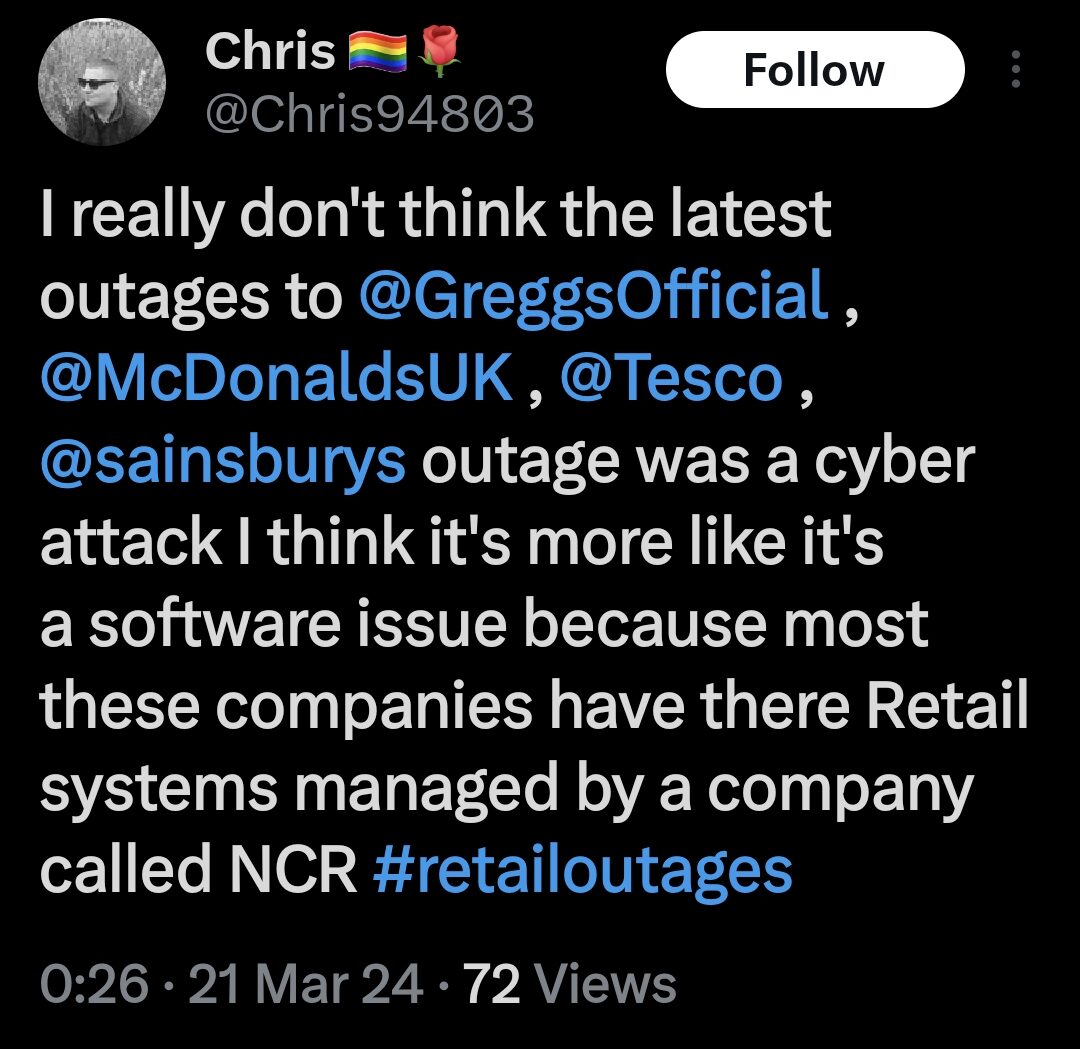NCR Payment system Cashless updates cause mayhem.
Last week several major retailers in the UK faced technical ‘glitches’ that disrupted their card payment systems.
Cyber attacks were ruled out because it appears that all of the companies involved in this outage rely upon NCR POS systems, tills, payment processing systems and CASHLINK ATM’s who use NCR software.
NCR pushed out an update that caused many of the payment systems to fail.
Sainsbury’s and Tesco staff reached out to me with comments.
1. Sainsbury’s:
On Saturday 16th March 2024, Sainsbury’s experienced card payment outages due to an overnight NCR software update. As a result, most online grocery deliveries were affected, and contactless payments in stores were disrupted. The exact cause of the software glitch remains under investigation according to Sainsbury’s. Their customers were not happy as many of them had already paid for their online shopping and were offered 3-5 day refunds instead of receiving their shopping. Sainsbury’s even joked with Greggs to ‘Hang on in there’.

2. Greggs:
The popular bakery chain encountered an NCR payment issue that affected some of its shops. Some of Greggs stores use J2 retail systems POS devices so were unaffected. Customers found certain branches closed or only able to accept cash.
However, Greggs has since resolved the problem, and all stores are now trading as usual.
The NCR technical issue impacted tills in some of their shops, leading to inconvenience for customers. Greggs apologized for any disruption caused.

3. Tesco:
Tesco claimed that they experienced unrelated technical issues (not NCR) and these issues forced Tesco to cancel a “small number” of orders. However, the specific details about the nature of these issues have not been disclosed.
Staff did appear on social media claiming that the NCR update had also affected their payment systems.
Tesco have added NCR self-checkout systems to their stores, which allow customers to scan, bag, and pay for goods themselves. This technology has been adopted in Tesco stores across the UK, Ireland, the U.S., South Korea, and Central and Eastern European countries. Tesco first started using NCR SelfServ Checkout in the UK in 2002, and more than 10 million Tesco shoppers now use them weekly throughout the UK.
4. McDonald’s:
Last Friday (15th March 2024), McDonald’s restaurants worldwide were unable to take orders due to a “global technology system outage.” The fast-food giant faced challenges with its ordering system, affecting customers across various locations.
While McDonalds do not use NCR POS systems they use the NCR hardware with their own inhouse NP6 software so from this we can deduce that this must have been a hardware affecting issue.
POS systems need monitoring
I’d like to emphasise two crucial insights:
1. The Significance of Cash: In a world gravitating towards cashless transactions, we must not overlook the potential for technical malfunctions. Without robust disaster recovery plans, such failures can lead to real-world consequences, including hunger. Physical currency remains an indispensable fallback, offering universal accessibility and convenience. Notably, numerous small enterprises are reverting to cash transactions, finding them less costly than their cashless counterparts.
2. The Vitality of Payment Systems: Payment systems are the backbone of our infrastructure, necessitating vigilant monitoring, consistent backups, and comprehensive disaster preparedness. The recent disruptions faced by several companies raise questions about their origins—could they stem from faulty hardware, flawed software updates, network alterations, or even scheduled maintenance? By leveraging SolarWinds technology, it’s possible to oversee SNMP OIDs across hardware, operating systems, servers, and inter-device connections, as well as applications and databases, ensuring visibility throughout any setup, including cloud environments. Preparedness is key, even when facing expected downtime. The financial repercussions of unpreparedness are too significant to ignore.
I contacted Sainsburys to see if they would like help monitoring their NCR infrastructure but they have not responded.








Leave A Comment